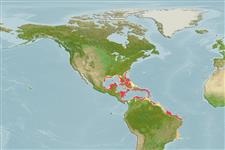Common names from other countries
Classification / Names / Names
Namen | Synonyme | Catalog of Fishes (gen., sp.) | ITIS | CoL | WoRMS
Environment: milieu / climate zone / depth range / distribution range
Ökologie
; tiefenbereich 0 - 88 m (Ref. 83435). Tropical; 34°N - 21°S, 97°W - 29°E
Eastern Central Pacific and Western Atlantic: North America.
Length at first maturity / Size / Gewicht / Alter
Maturity: Lm ? range ? - ? cm Max length : 3.4 cm NG Männchen/unbestimmt; (Ref. 83435)
This species is found in supra-, sub-, and intertidal coral reefs, reef lagoons, and cienaga facies, particularly on algae, boulder, coral, mud, sand, rock, seagrass and shell habitats (Ref. 83934).
Life cycle and mating behavior
Geschlechtsreife | Fortpflanzung | Ablaichen | Eier | Fecundity | Larven
Members of the order Neotaenioglossa are mostly gonochoric and broadcast spawners. Life cycle: Embryos develop into planktonic trocophore larvae and later into juvenile veligers before becoming fully grown adults.
Bright, T.J. 2010. (Ref. 85586)
IUCN Rote Liste Status (Ref. 130435)
CITES Status (Ref. 108899)
Not Evaluated
Not Evaluated
Nutzung durch Menschen
| FishSource |
Tools
Mehr Information
Alter/Größe
Wachstum
Länge-Gewicht
Länge-Länge
Morphologie
Larven
Dichte
Internet Quellen
Estimates based on models
Preferred temperature
(Ref.
115969): 23.6 - 28, mean 26.7 (based on 306 cells).
Preiskategorie
Unknown.
